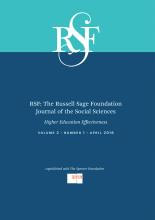Abstract
Has access to selective postsecondary schools expanded or contracted? Evaluating this question has proven a difficult task because data are limited, particularly with regard to family income. We complement previous work and provide a replicable model of institutional analysis. This paper presents a detailed, quantitative assessment of admissions at the University of Wisconsin-Madison, an elite flagship public university—the type that is supposed to offer excellent opportunities to students from all backgrounds. We use an innovative measure of family income to compare applicant, admissions, and enrollment trends for low-income and minority students from 1972 to 2007. The unique aspects of this study include the more reliable measure of income and the ability to look at the full process from applications, admissions, and matriculations (demand and supply), not generally available in national datasets.
- Copyright © 2016 by Russell Sage Foundation. All rights reserved. Printed in the United States of America. No part of this publication may be reproduced, stored in a retrieval system, or transmitted in any form or by any means, electronic, mechanical, photocopying, recording, or otherwise, without the prior written permission of the publisher. Reproduction by the United States Government in whole or in part is permitted for any purpose. Direct correspondence to: Sara Dahill-Brown at dahillse{at}wfu.edu, Department of Politics and International Affairs, Wake Forest University, P.O. Box 7568, Winston-Salem, NC 27109;John F. Witte at witte{at}lafollette.wisc.edu, 7418 Cedar Creek Trail, Madison, WI 53717; Barbara Wolfe at bwolfe{at}wisc.edu, 204 Observatory Hill Office Bldg., 1225 Observatory Dr., Madison, WI 53706.
Open Access Policy: RSF: The Russell Sage Foundation Journal of the Social Sciences is an open access journal. This article is published under a Creative Commons Attribution-NonCommercial-NoDerivs 3.0 Unported License.






